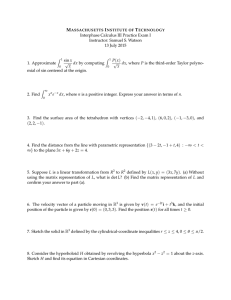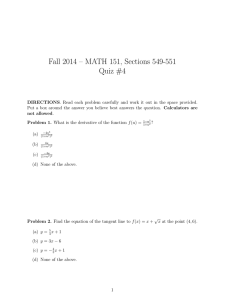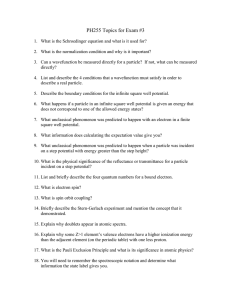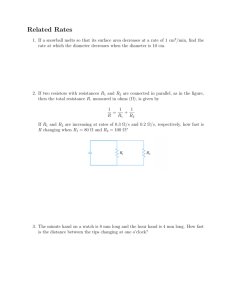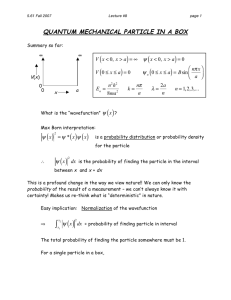Document 13490387
advertisement
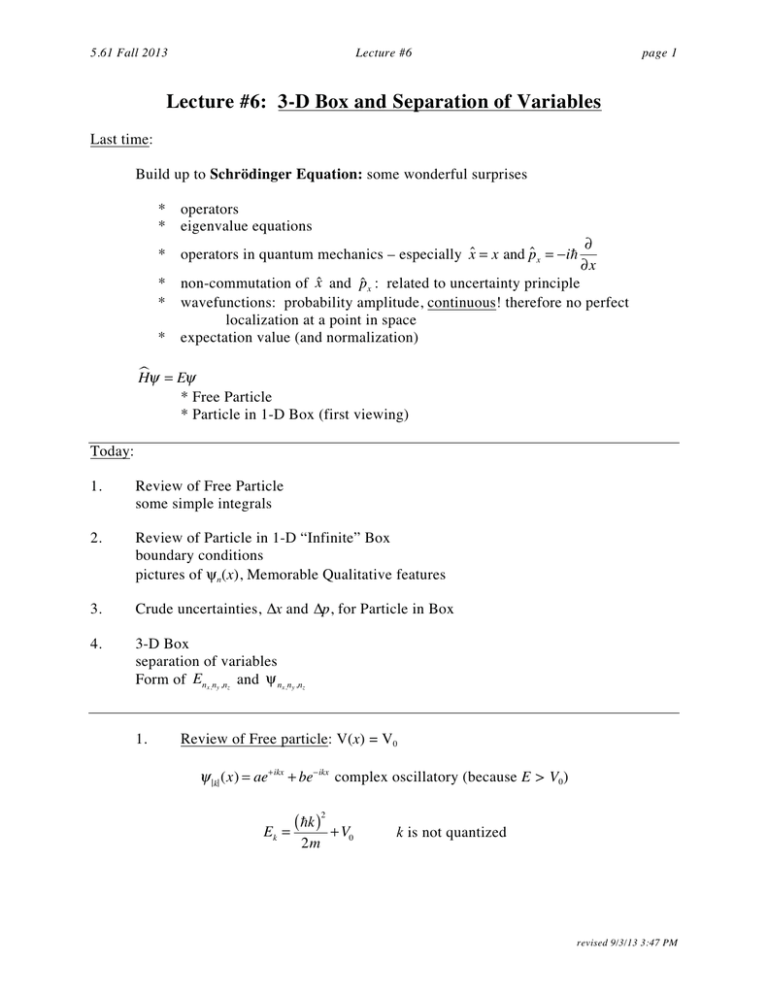
5.61 Fall 2013 Lecture #6 page 1 Lecture #6: 3-D Box and Separation of Variables Last time: Build up to Schrödinger Equation: some wonderful surprises * * operators eigenvalue equations * operators in quantum mechanics – especially x̂ = x and p̂x = −in ∂ ∂x * non-commutation of x̂ and p̂x : related to uncertainty principle * wavefunctions: probability amplitude, continuous! therefore no perfect localization at a point in space * expectation value (and normalization) Hψ = Eψ H * Free Particle * Particle in 1-D Box (first viewing) Today: 1. Review of Free Particle some simple integrals 2. Review of Particle in 1-D “Infinite” Box boundary conditions pictures of ψn(x), Memorable Qualitative features 3. Crude uncertainties, Δx and Δp, for Particle in Box 4. 3 -D Box separation of variables Form of Enx ,ny ,nz and ψ nx ,ny ,nz 1. Review of Free particle: V(x) = V0 ψ k (x) = ae+ikx + be−ikx complex oscillatory (because E > V0) Ek = ( nk )2 + V 2m 0 k is not quantized revised 9/3/13 3:47 PM 5.61 Fall 2013 Lecture #6 ∞ page 2 ∞ 2 2 2 ⎡ ψ dx = + + a *be−2ikx + ab * e2ikx ⎤⎦ dx a b (x) ∫−∞ k ∫−∞ ⎣ 2 (Note what happens to the product e–ikxe+ikx) 2 = a ∞ + b ∞ + a *b0 + ab * 0 can’t normalize ψ = aeikx to 1. ∫ ∞ −∞ ≈ dx a e−ikx e+ikx = ∫ dx a 2 2 −∞ which blows up. Instead, normalize to specified # of particles between x1 and x2. Questions: px2 ? ψ k (x) = aeikx + be−ikx an eigenfunction of p̂x ? Is e eigenfunction of p̂x ? What eigenvalue? Is What do your answers mean? ikx 2. Review of Particle in 1-D Box of length a, with infinitely high walls “infinite box” or “PIB” In view of its importance in starting you out thinking about quantum mechanical particle in a well problems, I will work through this problem again, carefully. E V(x) = 0 V(x) = ∞ 0 ≤ x ≤ a x < 0, x > a Region I Region II Region III Classically forbidden because E<V Classically forbidden x 0 a Consider regions I and III. E < V(x) revised 9/3/13 3:47 PM 5.61 Fall 2013 Lecture #6 page 3 2 2 d n H=− +∞ H 2 2m dx n 2 d 2ψ = ( ∞ − E )ψ 2 2m - dx ' - no matter what finite value we choose for E, the Schrödinger equation can only be satisfied by setting ψ (x) = 0 throughout regions I and III. finite So we know that ψ(x) = 0 x < 0, x > a. But ψ(x) must be continuous everywhere, thus ψ(0) = ψ(a) = 0. These are boundary conditions. Note, however, that for finite barrier height and width, we will eventually see that it is possible for ψ(x) to be nonzero in a classically forbidden [E < V(x)] region. “Tunneling.” (There will be a problem on Problem Set #3 about this.) So we solve for ψ(x) in Region II, which looks exactly like the free particle because V(x) = 0 in Region II. Free particle solution are written in sin, cos form rather than e±ikx form, because application of boundary conditions is simpler. [This is an example of finding a general principle and then trying to find a way to violate it.] ψ (x) = Asin kx + B cos kx Apply boundary conditions ψ (0) = 0 = 0 + B → B = 0 ψ (a) = 0 = Asin ka ⇒ ka = nπ , kn = nπ a 1/2 nπ x ⎛ 2⎞ →A=⎜ ⎟ Normalize: 1 = ∫ dxψ *ψ = A ∫ dx sin (Picture of normalization −∞ 0 ⎝ a⎠ a integrand suggests that the value of the normalization integral = a/2) ∞ 2 a 2 Non-Lecture Normalization integral for particle-in-a-box eigenfunctions revised 9/3/13 3:47 PM 5.61 Fall 2013 Lecture #6 page 4 ⎛ nπ ⎞ ψ n (x) = Asin ⎜ x ⎝ a ⎟⎠ Normalization (one particle in the box) requires ∫ ∞ −∞ dxψ *ψ = 1 . For V(x) = 0, 0 ≤ x ≤ a infinite wall box: 0 a ∞ −∞ 0 a 1 = ∫ dxψ *ψ + ∫ dxψ *ψ + ∫ dxψ *ψ = 0 + A 1= A 2 ∫ a 0 dx sin 2 2 ∫ a 0 dx sin 2 nπ x+0 a nπ x a Definite integral ∫ π 0 dysin 2 y = π 2 change variable: nπ x a nπ a dy = dx ⇒ dx = dy a nπ y= limits of integration: x=0⇒y=0 x = a ⇒ y = nπ nπ ⎛ a ⎞ a ⎛π⎞ a nπ 2 dx sin x = y = n⎜ ⎟ = dysin ∫0 ∫0 ⎜⎝ nπ ⎟⎠ nπ ⎝ 2 ⎠ 2 a a ⎛ 2⎞ thus A = ⎜ ⎟ ⎝ a⎠ a 1= A , 2 2 ⎛ 2⎞ ψ n (x) = ⎜ ⎟ ⎝ a⎠ 2 1/2 ⎛ nπ ⎞ sin ⎜ x ⎝ a ⎟⎠ 1/2 (A very good equation to remember!) End of Non-Lecture revised 9/3/13 3:47 PM 5.61 Fall 2013 Lecture #6 page 5 Find En. These are all of the allowed energy levels. Hψ = E ψ H n n n n2 d 2 ψ n = Enψ n 2m dx 2 2 n2 h 2 1 n 2π 2 ⎞ 2⎛ h + (kn )2 = En = = n ⎜ ⎟ 2 2 2⎠ ⎝ 2m a 2m 4 π n 2π 2 8ma − E1 a2 n = 1, 2, … n = 0 would correspond to empty box Energy levels are integer multiples of a common factor, En = E1n2. (This will turn out to be of special significance when we look at solutions of the time-dependent Schrödinger equation (Lecture #13). ........................... ........................... ..... ..... .... .... . . . . . .... .... . ... ... ....... . ... . . E3 .... .. . .... . . . . ..... ........................... ......................................... ....... ...... . . . . ..... .. . . . . ..... ... ....... ..... E2 ..... . . . ...... ..... ............ ....... . . . . . . . . . . . . . . . . . . . . . . . ............................................................... ............... ............ . . . . . . . . . . . ......... ..... . . . . ....... . . ... . ...... . . . . . . ....... . ... These are “stationary states”. You are not allowed to ask, if the system is in ψ3, how does the particle get from one side of a node to the other. How would you sample ψ3? What would you measure? [Quantum Mechanics is full of what/how is “in principle” measurable, hence knowable.] Could you measure ψ3? Could you measure |ψ3|2? E1 0 0 a zero point E All bound systems have their lowest energy level at an energy greater than the energy of the bottom of the well: “zero-point energy” This zero-point energy is a manifestation of the uncertainty principle. Why? What is the momentum of a state with zero kinetic energy? Is this momentum perfectly specified? What does that require about position? revised 9/3/13 3:47 PM 5.61 Fall 2013 Lecture #6 3. Crude estimates of Δx, Δp the next lecture) page 6 (we will make a more precise definition of uncertainty in Δx = a for all n (the width of the well) ⎛ nπ ⎞ Δ pn = + nkn − ( −nkn ) = 2n kn = 2n ⎜ ⎟ ⎝ a ⎠ p to right p to left = 2 2π ⎛ nπ ⎞ h ⎜ ⎟ = hn a ⎝ a ⎠ The joint uncertainty is Δ xn Δ pn = (a) hn = hn which increases linearly with n. a n = 0 would imply Δpn = 0 and the uncertainty principle would then require Δxn = ∞, which is impossible! This is an indirect reason for the existence of zero-point energy. Since the uncertainty principle is ΔxΔpx = h it appears that the n = 1 state is a minimum uncertainty state. It will be generally true that the lowest energy state in a well is a minimum uncertainty state. 4. Use the 3-D box to illustrate a very convenient general result: separation of variables. H in the form: Whenever it is possible to write H H = ĥ + ĥ + ĥ H x y z (provided that the additive terms are mutually commuting) p̂x2 + Vx (x̂) + etc. 2m it is possible to obtain ψ and E in separated form (which is exceptionally convenient!): ψ ( x, y, z ) = ψ x (x)ψ y (y)ψ z (z) E = E x + E y + Ez . Or, more generally, when revised 9/3/13 3:47 PM 5.61 Fall 2013 Lecture #6 page 7 n H = hˆ (q ) H ∑i i i=1 then n ψ = ∏ψ i (qi ) i=1 n E = ∑ Ei i=1 Consider the specific example of the 3-D box with edge lengths a, b, and c. 0 ≤ x ≤ a, 0 ≤ y ≤ b, 0 ≤ z ≤ c, otherwise V = ∞. V(x,y,z) = 0 This is a special case of V ( x, y, z ) = Vx + Vy + Vz . −n 2 T p̂x , p̂y , p̂z = 2m ( ) ⎡ ∂2 ∂2 ∂2 ⎤ ⎢ ∂x 2 + ∂y 2 + ∂z 2 ⎥ ⎣⎦ 2 ∇ “Laplacian” 2 2 2 2 2 2 H ( x, y, z ) = ⎡ −n ∂ + V (x̂) ⎤ + ⎡ −n ∂ + V (ŷ) ⎤ + ⎡ −n ∂ + V (ẑ) ⎤ H x y z ⎢ 2m ∂x 2 ⎥ ⎢ 2m ∂y 2 ⎥ ⎢ ⎥ 2 ⎣ ⎦ ⎣ ⎦ ⎣ 2m ∂z ⎦ = hˆ + ĥ + ĥ x y z Schrödinger Equation ⎡ ĥx + ĥy + ĥz ⎤ψ (x, y, z) = Eψ (x, y, z) ⎣ ⎦ try ψ (x, y, z) = ψ x (x)ψ y (y)ψ z (z), where ĥi operates only on ψ i , and ĥiψ i = Eiψ i are the solutions of the 1-D problem. ĥxψ ( x, y, z ) = ψ yψ z ĥxψ x = ψ yψ z Exψ x = Exψ xψ yψ z = Exψ ( x, y, z ) (does not operate on y, z) hˆ yψ = Eyψ xψ yψ z ĥzψ = Ezψ xψ yψ z ( ) Hψ = E + E + E ψ . ĥxψ + ĥyψ + ĥzψ = H x y z H is separable into additive (commuting) terms, then ψ can be So we have shown that, if H written as a product of independent factors, and E will be a sum of separate subsystem energies. Convenient! revised 9/3/13 3:47 PM 5.61 Fall 2013 Lecture #6 page 8 So, for the a,b,c box ψ nx = ( 2 a ) sin 1/2 ∫ a 0 n xπ , a Enx = nx2 h2 8ma 2 dxψ nx2 = 1 nyπ h2 2 ψ ny = ( 2 b ) sin , normalized, Eny = ny b 8mb 2 nzπ h2 1/2 2 ψ nz = ( 2 c ) sin , normalized, Enz = nz c 8mc 2 2 h 2 ⎡ nx2 ny nz2 ⎤ Enx ,ny ,nz = ⎢ 2+ 2+ 2⎥ 8m ⎣ a b c ⎦ 1/2 nyπ nzπ n xπ ⎛ 8 ⎞ ψ n x n y nz = ⎜ sin sin sin . ⎝ abc ⎟⎠ a b c 1/2 If each of the factors of ψ nx ,ny ,nz is normalized, it’s easy to show that ∫ 2 dx dy dz ψ nxnynz = 1 because each of the integrations acts on only one separable factor. This looks like a lot of algebra, but it really is an important, convenient, and frequently encountered simplification. H is not exactly separable We use this separable form for ψ and E all of the time, even when H (for example, a box with slightly rounded corners). (1) (0) H H H H =H +H a separable Hamiltonian that at we use to define a completee set of “basis functions” and “zero-order energies.” a correction term that contains what we would like c to t leave out. revised 9/3/13 3:47 PM 5.61 Fall 2013 Lecture #6 page 9 This is the basis for our intuition, names of things, and approximate energy level formulas. H (1) contains small inter-sub-system coupling terms that are dealt with by perturbation H theory (Lectures #15, #16 and #19). NEXT TIME we are going to look at some properties of a particle in a box. Some of these properties are based on simple insights, while others are based on actually evaluating the necessary integrals. x x2 σ x2 = x 2 − x 2 “variance” px px2 σ px σ xσ px FWHM Gaussian G(x − x0 , σ x ) [ x0 is “center”, σ x is “width” ] Lorentzian L(x − x0 , σ x ) Minimum Uncertainty Wavepacket revised 9/3/13 3:47 PM MIT OpenCourseWare http://ocw.mit.edu 5.61 Physical Chemistry Fall 2013 For information about citing these materials or our Terms of Use, visit: http://ocw.mit.edu/terms.
